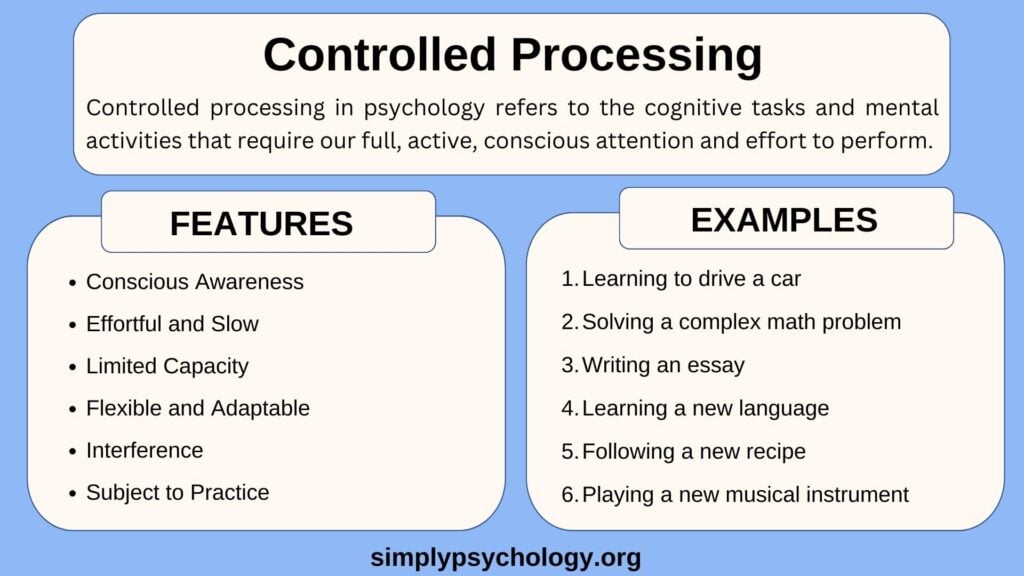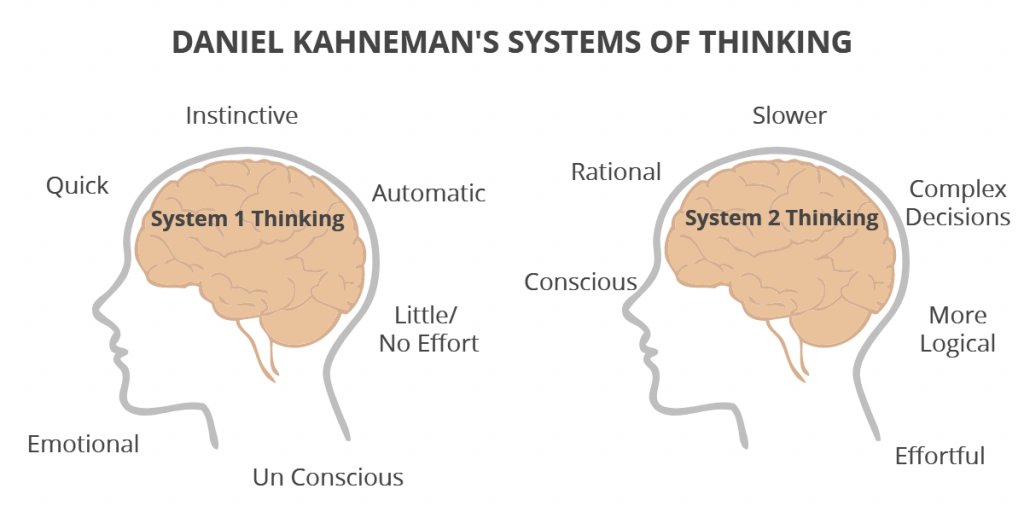On This Page:
Controlled processing is a conscious, intentional, and effortful method of information processing used when dealing with novel or complex situations or learning new skills (Schneider & Shiffrin, 1977).

This type of processing requires full attention and cognitive resources, often making it slower and more mentally taxing.
It is typically used when facing unfamiliar or complex situations that require careful consideration and logical reasoning to act most reasonably.
Controlled processing allows us to adapt and respond to new and unique situations that automatic (unconscious) processing cannot handle.
Humans use a lot of controlled processing in our daily lives, all requiring cognitive efforts and engagement in the thinking process.
For instance, when solving a complex math problem, engaging in a lively debate, or piecing together a complicated puzzle, we consider available information before making a final decision.
Key Features
- Conscious Awareness: The tasks or activities requiring controlled information processing require conscious attention and effort.
- Effortful and Slow: Controlled processing requires cognitive effort, is slower, and can be mentally exhausting.
- Limited Capacity: As it requires a significant amount of cognitive resources, we can only handle a limited number of controlled processing tasks simultaneously. This is often called cognitive load or the capacity of our working memory.
- Flexible and Adaptable: Controlled processing allows flexibility and adaptability in unfamiliar or changing situations.
- Interference: Given the limited capacity of our cognitive resources, simultaneous controlled processes can interfere with each other, reducing overall performance.
- Subject to Practice: With practice and repetition, tasks initially requiring controlled processing can become automatic, faster, less effortful, and can be performed unconsciously.
Examples of Controlled Processing
Controlled processing in psychology is a form of information processing that requires active conscious attention and effort. These tasks often involve new or complex situations that our automatic processing systems cannot handle.
Schneider and Shiffrin (1977) defined controlled processing as “a temporary sequence of nodes activated under control of, and through attention by, the subject.”
Here are some examples:
- Learning a New Language: Learning a new language involves intense cognitive processing to understand vocabulary, grammar rules, pronunciation, etc., which requires controlled processing.
- Solving Math Problems: Controlled processing is needed when doing math problems, especially complex ones that involve multiple steps and different areas of math knowledge.
- Learning to Drive: As a beginner, driving requires full attention, such as changing gears, steering, looking at mirrors, watching for traffic signals, etc. This is a perfect example of controlled processing.
- Playing a New Musical Instrument: Learning to play a new instrument requires controlled processing, focusing on finger placement, reading sheet music, and listening to the sounds produced.
- Navigating an Unfamiliar Area: Walking or driving through a new city or area that one is unfamiliar with requires active, conscious processing to understand the directions and to remember landmarks.
- Learning a New Sport: When first learning the rules, techniques, and strategies of a new sport, you use controlled processing.
- Writing a Research Paper: Controlled processing is used when one needs to organize thoughts, write understandably, provide a logical argument, and avoid plagiarism.
- Preparing a Presentation: Completing a complex presentation requires attention to detail, information structuring, and audience engagement planning. All of this requires controlled processing.
- Cooking a New Recipe: Following a new recipe, especially a complex one, requires controlled processing. One has to pay attention to the instructions, measure ingredients accurately, and manage the cooking process.
Remember that with practice, many tasks that initially require controlled processing can become automatic, requiring less conscious attention and effort.
Advantages
The advantages of controlled processing are complementary to the disadvantages of automatic processing. Controlled processing is less prone to mistakes, easily altered and learned, and performs better in novel situations (Schneider & Chein, 2003).
The results of controlled processing are more reliable and less likely to make careless mistakes than automatic processing. By carefully considering all available information, weighing the pros and cons, and making a rational decision, individuals are more likely to arrive at accurate conclusions and avoid errors.
For example, when writing a paper for a class, controlled processing is used to review and analyze the data carefully, paying close attention to detail. Through controlled processing, you are less likely to make careless mistakes such as leaving out important information or misinterpreting data.
Another advantage of controlled processing is that new skills can be learned quickly and is easy to alter and change. For instance, learning a new language may require much effort and attention.
However, as a person becomes more proficient in the language, they may find it easier to alter their language usage depending on context and situation, showing adaptability and flexibility of controlled processing.
Moreover, with controlled processing, learning can be passed between individuals through observation or instruction, and behaviors with specific goals can be planned and conducted accordingly.
Disadvantages
The disadvantages of controlled processing are obvious, including things such as long execution time, high efforts, easily influenced by stressors, and inability to allow processes to occur parallel.
Controlled processing requires more brain power, time, and effort from people, so it can only operate simultaneously on a given number of stimuli. People do not have an unlimited capacity for cognitive load, and constantly having a high cognitive load may leave the brain tired and impair performance, leading to mental fatigue.
Research by Linden et al. (2003) found that people experiencing mental fatigue due to working on cognitively demanding tasks perform worse and make more errors in doing tasks.
Moreover, research has found that controlled processing is susceptible to the influence of stress, with decreased performance seen as stress increases (Schneider & Chein, 2003).
This could be problematic if undivided attention is needed for a task, but people cannot perform optimally. An example would be students during exams; some may experience high-stress levels, ultimately impairing their scores.
To conclude, both automatic and controlled processing are important ways humans think and operate successfully in our daily lives. The useful combination of both processes helps make life more efficient.
System 2 Thinking
In cognitive psychology, controlled processing, which is slow, effortful, and conscious, can be mapped onto the concept of System 2 thinking as described by Daniel Kahneman in his book, “Thinking, Fast and Slow.”
This thinking typically comes into play when working on complex problems, making decisions, or evaluating options.
Kahneman’s theory is considered a dual-process theory because it posits these two distinct systems for processing information:
- System 1: Fast, automatic, intuitive, and largely unconscious. It’s the thinking you use when walking, engaging in a practiced skill, or quickly calculating a simple sum.
- System 2: Slow, effortful, logical, conscious, and often associated with the subjective experience of concentration. An example might be calculating a complex math problem or deciding where to invest money.

System 2 can follow rules, compare objects on several attributes, and make deliberate decisions. It is also associated with the subjective experience of agency, choice, and concentration. It requires more mental energy than System 1 thinking, which is more automatic, intuitive, and quick.
When faced with unfamiliar situations, we rely on system 2 thinking as it is less prone to errors. However, when we use system 1 thinking, we use mental shortcuts called heuristics, which may lead to illogical decision-making.
System 2 thinking, while more effortful, is crucial for making reasoned judgments and decisions. It also helps us override potentially biased or impulsive responses that could arise from System 1.
However, because System 2 is more cognitively taxing and slower, we can’t rely on it all the time, and thus, we often use System 1 for many of our daily tasks and decisions.
References
Evans, J. S. B., & Stanovich, K. E. (2013). Dual-process theories of higher cognition: Advancing the debate. Perspectives on psychological science, 8(3), 223-241.
Greenwald, A. G., & Krieger, L. H. (2006). Implicit bias: Scientific foundations. California Law Review, 94(4), 945-967.
Higgins, E. T., & Bargh, J. A. (1987). Social cognition and social perception. Annual Review of Psychology, 38, 369-425.
Kahneman, D. (2013). Thinking, fast and slow. Farrar, Straus and Giroux.
Kendra Cherry, Mse. (2021, June 18). How priming affects the psychology of memory. Verywell Mind. https://www.verywellmind.com/priming-and-the-psychology-of-memory-4173092
Poldrack, R. A., Sabb, F. W., Foerde, K., Tom, S. M., Asarnow, R. F., Bookheimer, S. Y., & Knowlton, B. J. (2005). The neural correlates of motor skill automaticity. The Journal of Neuroscience: the official journal of the Society for Neuroscience, 25(22), 5356–5364.
Posner, M. I., Snyder, C. R., & Solso, R. (2004). Attention and cognitive control. Cognitive psychology: Key readings, 205, 55-85.
Schacter, D. L., & Buckner, R. L. (1998). Priming and the brain. Neuron, 20(2), 185-195.
Schneider, W., & Chein, J. M. (2003). Controlled & Automatic Processing: Behavior, theory, and Biological Mechanisms. Cognitive Science, 27(3), 525–559.
Schneider, W., & Pimm-Smith, M. (1997). Consciousness as a message aware control mechanism to modulate cognitive processing. In J. Cohen & J. Schooler (Eds.), Scientific approaches to consciousness: 25th Carnegie symposium on cognition (pp. 65–80). Mahwah, NJ: Lawrence Erlbaum
Schneider, W., & Shiffrin, R. M. (1977). Controlled and automatic human information processing: I. Detection, search, and attention. Psychological Review, 84(1), 1-66.
Stanovich, K. E., & West, R. F. (2000). Individual differences in reasoning: Implications for the rationality debate Behavioral and Brain Sciences, 23(5), 645–665.
van der Linden, D., Frese, M., & Meijman, T. F. (2003). Mental fatigue and the control of cognitive processes: effects on perseveration and planning. Acta psychologica, 113(1), 45–65.

